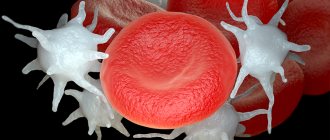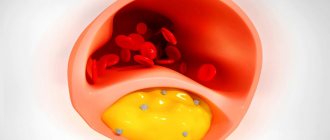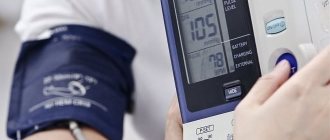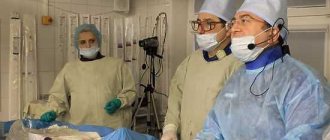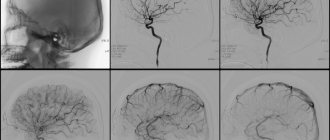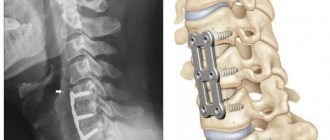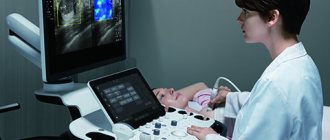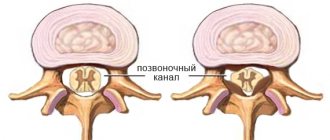Diagnosis of atherosclerosis of the carotid arteries
To prevent atherosclerosis of the carotid arteries from becoming a life-threatening diagnosis, careful examination and proper treatment are needed.
After a meeting with a doctor and a thorough examination, instrumental diagnostics are performed - duplex scanning. This is an ultrasound examination that does not require preparation and lasts 15-20 minutes.
If ultrasound results reveal atherosclerosis of the carotid arteries, requiring surgical intervention, angiography is also performed. The equipment in our clinic allows us to obtain high-quality images with the possibility of 3D reconstruction of the vascular bed. Thanks to this, the doctor receives the necessary information even about the condition of those vessels that ultrasound “does not see.”
How to treat cerebral vascular atherosclerosis
Treatment of dyslipidemia begins with non-drug measures. Doctors recommend lifestyle changes - quit smoking, control weight, exercise, eat right (limit foods high in cholesterol). The diet for atherosclerosis of the blood vessels of the legs includes the consumption of whole grains, a sufficient amount of vegetables, fruits, fish, and seafood.
If there is no effect from non-drug measures, antihyperlipidemic drugs are prescribed. The main drugs for the treatment of atherosclerosis are statins. Their use significantly improves the prognosis of life of patients with atherosclerosis. Studies have shown that drug therapy helps reduce low-density lipoprotein (LDL) cholesterol by 20% and total cholesterol by 26%. Mortality with regular use of statins is reduced by 22%.
Atherosclerosis is a systemic disease; despite different pools, it is treated pathogenetically in the same way - Statins, GI sequestrants (if statins are ineffective or contraindicated). And also symptomatically, depending on the area of the lesion and the severity of atherosclerotic stenosis of the atreria. For critical stenoses, surgical intervention is recommended, the type of which is determined by surgeons together with cardiologists
Read more about how to treat cerebral vascular atherosclerosis on our website.
Related services: Cardiac Check-up Diagnosis of heart rhythm disorders by ECG monitoring
Treatment of atherosclerosis
Treatment tactics for carotid artery atherosclerosis depend on the advanced stage of the disease. At the initial stage, medications are used that slow down the growth of plaques and improve blood properties, more than halving the risk of stroke.
In cases of severe atherosclerosis, when carotid artery plaques reach 70% of the cross-sectional area of the vessel and/or have a loose surface, surgical intervention is possible.
Surgery
If there is significant damage to the carotid arteries, surgical treatment may be required. Signs of a serious illness include transient ischemic attacks and a recent stroke. However, a significant number of patients may have no complaints even with very severe damage to the carotid arteries.
The surgical operation consists of removing the atherosclerotic plaque. This procedure is called a carotid endarterectomy.
Damage to the vessels of the neck
Damage to the vessels of the neck (precerebral sections of the arteries of the brain).
The brachiocephalic arteries (BCA) are the main vessels of the body. BCAs include:
- brachiocephalic trunk,
- common carotid artery (divided into internal and external arteries)
- subclavian arteries,
- vertebral arteries.
The anatomy of the vertebral arteries is often individual. The internal carotid and vertebral arteries (also known as the precerebral sections of the arteries of the brain) after penetrating into the skull form the Circle of Willis. This anatomical formation is designed to ensure uniform distribution of blood throughout all parts of the brain.
The problem is that the anatomy of the Circle of Willis is also variable and more than 20% of people in the European population have an open circle. With this anatomical feature, it is enough to stop blood circulation even in one of the arteries for the development of a stroke (death of brain tissue).
However, the overwhelming number of ischemic strokes are embologenic . This means that the cause of the disease is clogging of the arteries of the brain with material objects.
Embolism can be caused by blood clots from the cavities of the heart (if it is pathological), but most often they are fragments of disintegrating atherosclerotic plaques from the carotid arteries and the zone of division of the common carotid artery into internal and external (bifurcation zone). It is the bifurcation zone that is a typical place for the emergence and development of an atherosclerotic plaque.
Plaques, in turn, are divided into different types and classified according to the degree of narrowing of the vessel. The most dangerous are embologenic plaques - that is, those that can collapse at any moment and all their contents will instantly clog many arteries of the brain and cause a stroke.
Precursors of a stroke may be:
- headache;
- dizziness;
- numbness of half the body;
- visual impairment;
- difficulties in formulating thoughts.
- articulation disorder
- disturbances in the fine functions of the hands (for example, when writing)
- difficulty walking, etc.
Very often, a stroke occurs without any warning signs. That is why ultrasound diagnostics of the neck arteries (triplex, duplex scanning) is an absolutely necessary procedure for men and women after 40-50 years.
Angiosurgeons of the St. Petersburg Hospital of the Russian Academy of Sciences use various methods of treating atherosclerosis of the central artery, in the case of the carotid arteries, this is primarily carotid endarterectomy - a radical surgical treatment that allows removing the plaque and restoring the integrity of the vessel wall.
The operation is performed using a technique that ensures the highest possible degree of brain protection and microsurgical restoration of the artery.
Today, carotid endarterectomy gives the most consistent positive results over long-term follow-up periods - from 5 to 20~25 years. That is why in countries with developed medicine, carotid endarterectomy is the main method of treating this pathology.
For other affected areas, the St. Petersburg Hospital of the Russian Academy of Sciences performs arterial transplantations and bypass operations.
You can get expert advice and find out more details through the contact center 323 45 35
Causes
The main reason why atherosclerosis of the cervical vessels develops is a violation of fat and protein metabolism. However, it is impossible to determine exactly why pathological changes begin to appear in the vascular walls. There are several theories that can explain the onset of the disease development mechanism:
- lipoprotein infiltration - states that lipoproteins primarily accumulate on the inner surface of blood vessels, which then permeate it and form atherosclerotic plaques;
- dysfunction of the endothelium - initially the inner wall of the arteries undergoes pathological changes, as a result of which its protective properties are lost;
- autoimmune - a disease associated with a disruption of the immune system, as a result of which its cells (leukocytes and macrophages) settle on the inner surface of blood vessels;
- monoclonal - changes in the composition of smooth muscle cells that form the middle lining of the arteries;
- peroxide - disruption of the body's antioxidant system, intense reactions of lipid peroxidation, which leads to the processes of premature aging and apoptosis (programmed death) of cells;
- other theories, including viral, hormonal and genetic - each of them has scientific evidence.
In the neck area passes the common carotid artery, which further branches and forms several branches. This is a paired main artery, which is responsible for the blood supply to the skin, muscles, organs of the neck and head, including the brain. It is just as susceptible to the development of atherosclerosis as small vessels.
IMPORTANT! Atherosclerosis in the neck area poses a danger to human life. Atherosclerotic plaques clog blood vessels and prevent normal blood flow to the brain.
Clinical types of the syndrome
Posterior cervical sympathetic syndrome (Barre–Lieu)
Posterior cervical syndrome is characterized by headaches localized in the cervical-occipital region with radiation to the front of the head. The headache is usually constant, often in the morning, especially after sleeping on an uncomfortable pillow. Headache may occur when walking, driving a car, or when moving the neck. The headache can also be pulsating, piercing, localized in the cervical-occipital region and radiating to the parietal frontal and temporal zones. Headache may intensify when turning the head and is accompanied by vestibular, visual and autonomic disorders.
Migraine basilar
Basilar migraine does not result from compression of the vertebral artery, but from stenosis of the vertebral artery, but clinically has much in common with other forms of vertebral artery syndrome. As a rule, a migraine attack begins with a sharp headache in the back of the head, vomiting, and sometimes loss of consciousness. Visual disturbances, dizziness, dysarthria, and ataxia are also possible.
Vestibulo-cochlear syndrome
Disturbances from the hearing system manifest themselves in the form of noise in the head, decreased perception of whispered speech and are recorded by changes in data during audiometry. Tinnitus is persistent and long-lasting and tends to change when the head moves. Cochlear disorders are associated with dizziness (both systemic and non-systemic).
Ophthalmic syndrome
With ophthalmic syndrome in the foreground, visual disturbances such as scintillating scotoma, decreased vision, photopsia may also be symptoms of conjunctivitis (lacrimation, conjunctival hyperemia). Loss of visual fields can be episodic and is mainly associated with changes in head position.
Autonomic change syndrome
As a rule, autonomic disorders do not appear in isolation, but are combined with one of the syndromes. Autonomic symptoms are usually the following: a feeling of heat, a feeling of cold extremities, sweating, changes in skin dermographism, sleep disturbances.
Transient ischemic attacks
Ischemic attacks can occur during the ischemic stage of vertebral artery syndrome. The most common symptoms of such attacks are: transient motor and sensory disturbances, visual disturbances, hemianopsia, ataxia, attacks of dizziness, nausea, vomiting, speech impairment, swallowing, double vision.
Syncopal vertebral syndrome (Unterharnscheit syndrome)
An episode of syncopal vertebral syndrome is an acute circulatory disorder in the area of the reticular formation of the brain. This episode is characterized by a short-term loss of consciousness when turning the head suddenly.
Drop attack episodes
An episode of a drop attack (fall) is caused by impaired blood circulation in the caudal parts of the brainstem and cerebellum and will clinically manifest itself as tetraplegia when the head is thrown back. Restoration of motor functions is quite rapid.
Diagnostic methods
Early diagnosis of atherosclerosis is the key to its successful treatment and prevention of dangerous complications. If you experience frequent headaches, dizziness and other signs of illness, you should consult a doctor to determine their cause. The examination scheme is selected individually and may include the following methods:
- physical examination and medical history, including changes in blood pressure;
- blood tests - the concentration of various fractions of cholesterol and lipoproteins is determined in the laboratory;
- Dopplerography - ultrasound examination of blood flow velocity in a certain area, carried out using a contrast agent;
- Computed angiography is a modern technique that allows you to track not only the characteristics of blood flow, but also the exact location and structure of blood vessels in the area under study.
Preventive examinations are recommended annually after the age of 50 years. They are necessary to detect the disease in its early stages, at which its development can be stopped.
It is impossible to make an accurate diagnosis at home; this will require complex instrumental techniques
Risk factors
According to statistics, atherosclerosis of the vessels of the neck and head is more common in men. Most patients with pronounced clinical signs are over 55–60 years of age. This is due to age-related changes in cells and tissues, deterioration of blood circulation, and a decrease in the strength and elasticity of vascular walls.
Pathological changes in atherosclerosis are irreversible - deposits on the internal walls do not resolve
There are risk factors that make the appearance of plaques in blood vessels more likely. These include:
- smoking - nicotine, tar and other components of cigarette smoke have a detrimental effect on blood vessels;
- chronic increase in blood pressure up to 140/90 mm Hg. Art. and more;
- violation of fat, protein, carbohydrate metabolism;
- hereditary predisposition - a history of atherosclerosis in relatives;
- unhealthy diet – high content of cholesterol source in the diet (animal fats);
- sedentary lifestyle, obesity;
- chronic diseases of the endocrine system (diabetes mellitus);
- infectious diseases;
- disorders of blood clotting and its viscosity indicators.
It is important to understand that cholesterol is normally present in the blood. It is also impossible and ineffective as a preventive measure to completely abandon products that contain it. Pathological changes begin only when this substance begins to accumulate in the vascular walls. They can be triggered by various factors, including chronic metabolic diseases, disorders of cholesterol metabolism and age-related changes.
Types and stages of atherosclerosis of the cervical arteries
Atherosclerosis is a chronic disease that progresses over time. There are several stages in the development of the disease, which replace each other as it develops. Each of them is characterized by certain biochemical changes in the internal walls of the arteries.
- The first is the fat stain stage. At this stage, the movement of blood through the vessels is not difficult, but lipids and cholesterol accumulate on the endothelium. The enzymes that are activated to break them down do not cope with their functions, so fat deposits increase. The vascular wall becomes loose, less strong and elastic.
- Liposclerosis is the second stage, at which the accumulation of not only fat, but also connective tissue occurs. This leads to the formation of an atherosclerotic plaque. At first it is liquid and can dissolve, but then it becomes dense.
- Atherocalcinosis is the accumulation of calcium salts in the chemical composition of the plaque. Due to this element, it becomes strong and clogs the lumen of the artery, causing disruption of blood flow.
Depending on the stage of atherosclerosis, the nature of its course and other factors, several types of this disease are distinguished. They differ in symptoms and degree of danger for the patient:
- non-stenotic - atherosclerosis, in which there is no narrowing of the lumen of the arteries, can be diagnosed in the early stages;
- stenosing - deposits and plaques cause narrowing of the vessel and a decrease in blood flow to the brain;
- obliterating - manifests itself when plaques form, which partially or completely block the vessels of the neck.
REFERENCE! A dangerous complication of atherosclerosis is the formation of a plaque, which then breaks off from the inner surface of the vessel and migrates with the bloodstream. It can cause acute cerebrovascular accident - ischemic stroke.
